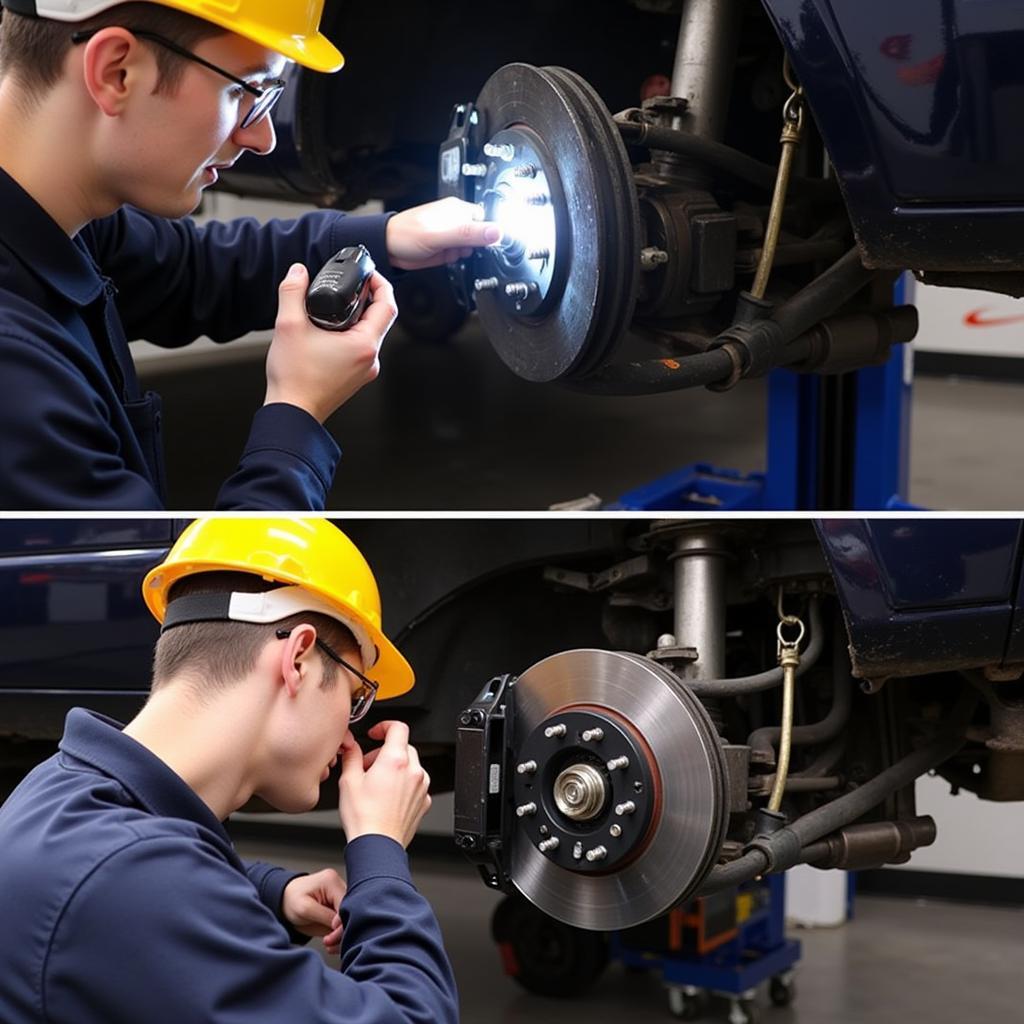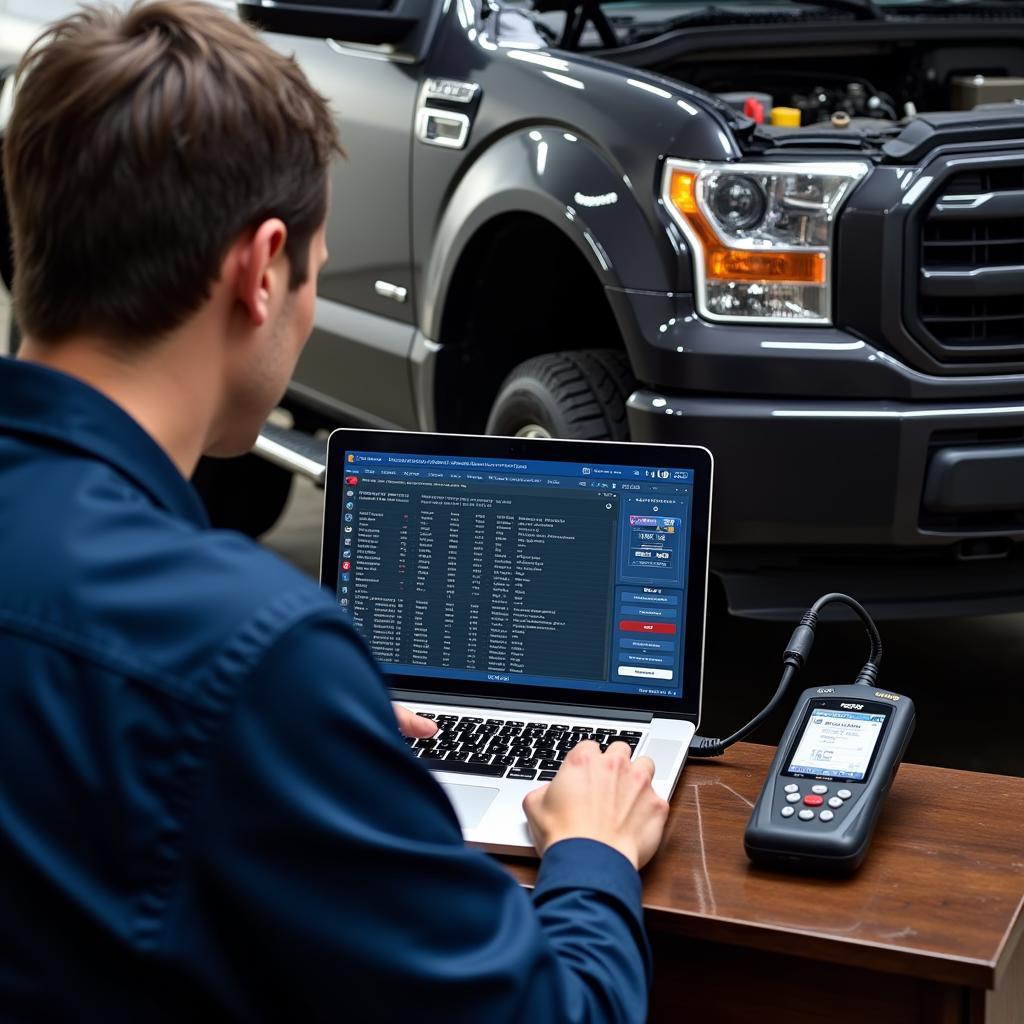The dreaded brake wear warning light on your Ford F-150 dashboard – a sight that can make even the most experienced driver’s stomach drop. This amber symbol, often accompanied by a jarring sound, signals potential issues with your braking system, specifically your disc pads. While a trip to the mechanic might seem inevitable, understanding the potential causes and solutions can help you navigate this situation with confidence.
Deciphering the Ford F-150 Brake Wear Warning Light
The brake wear warning light is designed to alert you about one primary concern: thinning brake pads. As you use your F-150’s brakes, the friction material on the brake pads gradually wears down. When this material reaches a critically low level, a sensor within the brake system triggers the warning light.
 Ford F-150 dashboard with brake warning light illuminated
Ford F-150 dashboard with brake warning light illuminated
However, this light can also indicate other issues within the braking system:
- Worn Brake Rotors: Uneven wear or deep grooves on your rotors can also trigger the warning light.
- Brake Fluid Leak: Low brake fluid levels, often due to a leak, will also illuminate the warning light.
- Faulty Brake Sensor: In some cases, a malfunctioning sensor itself might be the culprit, triggering a false alarm.
Addressing the Brake Wear Warning: A Step-by-Step Guide
Ignoring the brake wear warning light is never an option. Addressing the issue promptly is crucial for your safety and that of your passengers.
- Check Your Brake Pads: Begin by visually inspecting your brake pads. If you see less than ¼ inch of friction material remaining, they need replacement.
- Inspect Brake Rotors: Look for any deep grooves or uneven wear on your brake rotors. If present, they likely need resurfacing or replacement.
- Check Brake Fluid Levels: Locate your brake fluid reservoir and check the fluid level. If it’s low, there might be a leak.
- Seek Professional Assistance: If you are unsure about any aspect of your brake system or suspect a more complex issue, contact a qualified mechanic immediately.
 A person inspecting the brake pads on a Ford F-150
A person inspecting the brake pads on a Ford F-150
Beyond Disc Pads: The Bigger Picture of F-150 Brake Maintenance
While addressing the immediate concern triggered by the brake wear warning is vital, proactive maintenance can prevent many brake-related problems.
- Regular Inspections: Schedule routine brake inspections with a trusted mechanic, especially if you frequently tow heavy loads or drive in demanding conditions.
- Brake Fluid Flushes: Have your brake fluid flushed and replaced according to your F-150’s recommended maintenance schedule.
- Quality Parts: Always opt for high-quality brake pads and rotors from reputable brands.
“Investing in quality brake components and regular maintenance is not just about extending the life of your brakes,” says veteran mechanic Mark Jenkins. “It’s about ensuring your safety and the safety of those around you on the road.”
When Remote Diagnostics Come into Play
In today’s technologically advanced world, remote diagnostics are transforming how we approach car maintenance. Specialized software allows certified technicians to access your F-150’s onboard computer remotely, diagnose certain issues, and even program and install software updates.
While remote diagnostics can’t physically replace worn brake pads, they can be instrumental in identifying the root cause of the brake wear warning light. This can save you time and money by avoiding unnecessary repairs.
 Mechanic using a laptop to perform remote diagnostics on a Ford F-150
Mechanic using a laptop to perform remote diagnostics on a Ford F-150
Ford F-150 Brake Wear Warning: Addressing the Issue Head-On
The brake wear warning light in your Ford F-150 is a crucial safety feature, not a suggestion. Whether it indicates worn-out disc pads, a brake fluid leak, or another issue within the braking system, immediate attention is paramount. By understanding the potential causes, following the recommended steps, and prioritizing proactive maintenance, you can ensure optimal braking performance and, most importantly, your safety on the road.

